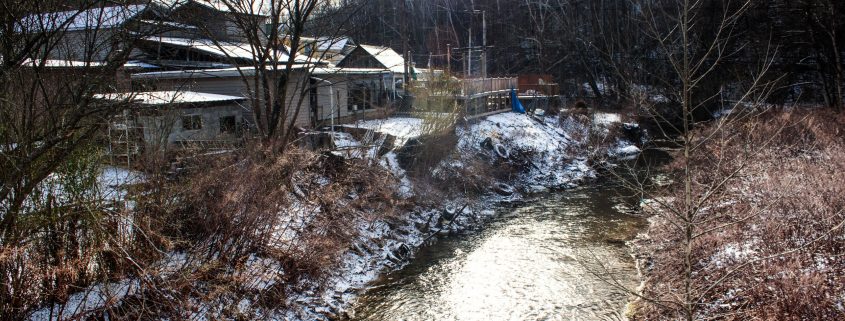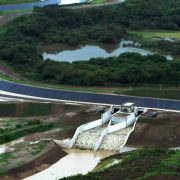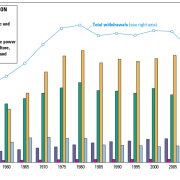Straight Pipes Foul Kentucky’s Long Quest to Clean Its Soiled Waters
A two-decade mission to reduce sewage pollution still has a lot of work to finish.
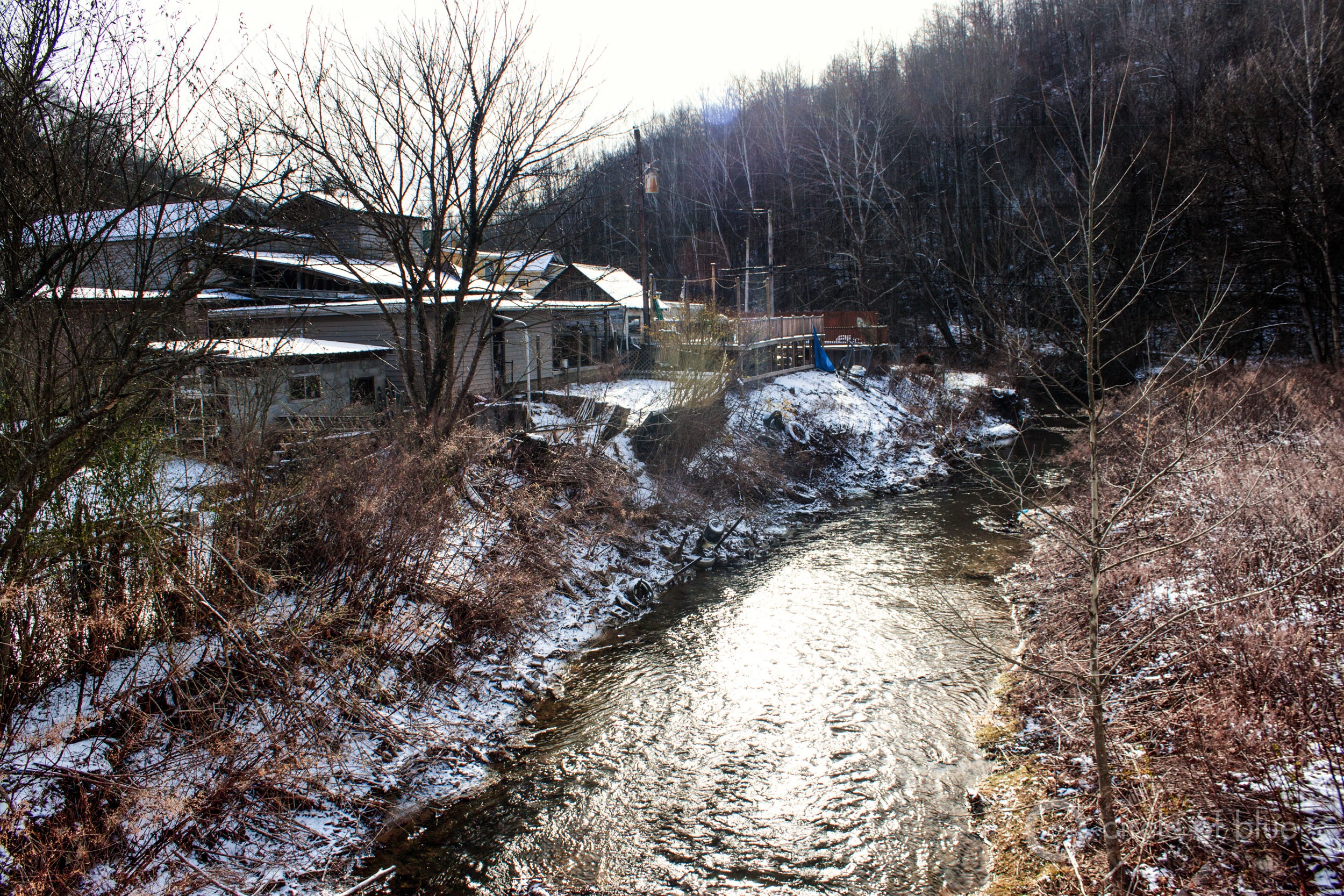
Adjacent to the small community of Millstone, in Letcher County, the North Fork of the Kentucky River has notoriously high fecal coliform measurements due to raw sewage. Photo © Brett Walton / Circle of Blue
By Brett Walton, Circle of Blue
HARLAN COUNTY, KY — In the mountains of eastern Kentucky a creek is often steps away from the front porch or back door. Here in Loyall, several dozen homes rim a bend close to the Cumberland River. Amid the brambles on the bank at least one white PVC pipe, a couple inches in diameter, pokes out of the ground and points toward the water.
Though it could be coming from a gutter or laundry room, the pipe displays the characteristic stealth of a drain straight from a toilet. Straight pipes, as they are known, are a dangerous and illegal scourge in this economically disadvantaged region of Kentucky. Though the state has spent decades and hundreds of millions of dollars to build contemporary treatment systems, straight pipes still proliferate, flushing raw human waste directly into creeks, streams, lakes, ravines, and backyard sumps.
Straight pipes in Kentucky join malfunctioning treatment plants and failing septic systems in producing a sewage pollution crisis in eastern Kentucky that is worse than water contamination from coal mining, according to state surveys.
Though data on straight pipe use is fragmented and incomplete, it is plain that rural Kentucky families rely on the rudimentary waste disposal method in sizable numbers. Circle of Blue filed a public records request and obtained 6,475 citizen water pollution complaints to the state Division of Water from January 2013 through January 2018. More than 700 are categorized as a straight pipe issue.
The complaints almost uniformly reflect profound concerns about living in filth:
“Caller reports that neighbor has a straight pipe draining to a ditch at the front of the property with visible toilet paper and a failing septic system in the backyard that is affecting her pond,” according to a complaint from Rowan County on July 25, 2013.
“Human waste going into the creek from two small buildings on the property,” according to a filing from Knox County on September 26, 2016. “Property owner lives in the Double-wide.”
According to a report from McCreary County on January 30, 2017, health officials struggled to get an owner to fix his pipes. “In Strunk, KY the log cabin duplex has been investigated several times,” the complaint states. “The septic system is discharging raw sewage onto neighboring properties. But the local health department allegedly is not having any success in gaining compliance. The concern is soil contamination and runoff going to the creek.”
“Sewage leaking from all three homes on right, up Boggs Lane,” states another complaint, from August 2013. “None were hooked on to the city sewer last year as required.”
“Sewer is running out of the ground,” according to a complaint from Harlan County that was filed on September 12, 2016. “The old septic tank failed. To fix the problem they dug a new line and put in a straight pipe. The pipe is hidden under some brush on her property.”
Some residents tolerate foul conditions for a time. But one homeowner in Laurel County whose yard was being inundated with sewage finally reached a breaking point on July 27, 2016. “The sewage is coming from 2 houses around his property,” according to the Division of Water’s records. “Reporter has put gravel and dirt on area where sewage is leaking onto his property. But the problem has gotten so bad he is unable to continue to cover up neighbor’s mess.”
State Aware and Not Effective Enough
The goal of eliminating straight pipes has eluded Kentucky for over two decades. In the late 1990s, then-Gov. Paul Patton and Rep. Hal Rogers, who still represents eastern Kentucky’s 5th District in Congress, championed state and federal initiatives to invest in drinking water and sewer infrastructure for all Kentuckians. Straight pipes in 40 eastern Kentucky counties would be eradicated, the Patton administration proclaimed. Sewer lines would parallel the region’s forks and branches. Every home would have access to contemporary sewage treatment and to drinking water from a municipal provider.
The program was partially successful. Tens of thousands of straight pipes and broken septic systems were removed or repaired, according to Eastern Kentucky PRIDE, a group that works on sewage issues.
Sewage pollution today is not at the crisis levels noted sixteen years ago in a U.S. Environmental Protection Agency report that said sanitary conditions in Bath, Harlan, Martin, and Montgomery counties were “of the highest concern” and “an environmental crisis which deserves attention from all levels of government.” The Kentucky Water Resources Research Institute, a unit of the University of Kentucky, tested the North Fork of the Kentucky River from 1998 to 2005. The researchers found a general trend toward improved water quality.
One big help was a 1998 state law that required new homes to show proof of a properly installed septic system before a power company was allowed to begin electric service. “No septic, no electric,” said Kevin Nickles, an environmental specialist who has worked for the Letcher County Health Department since 1994.
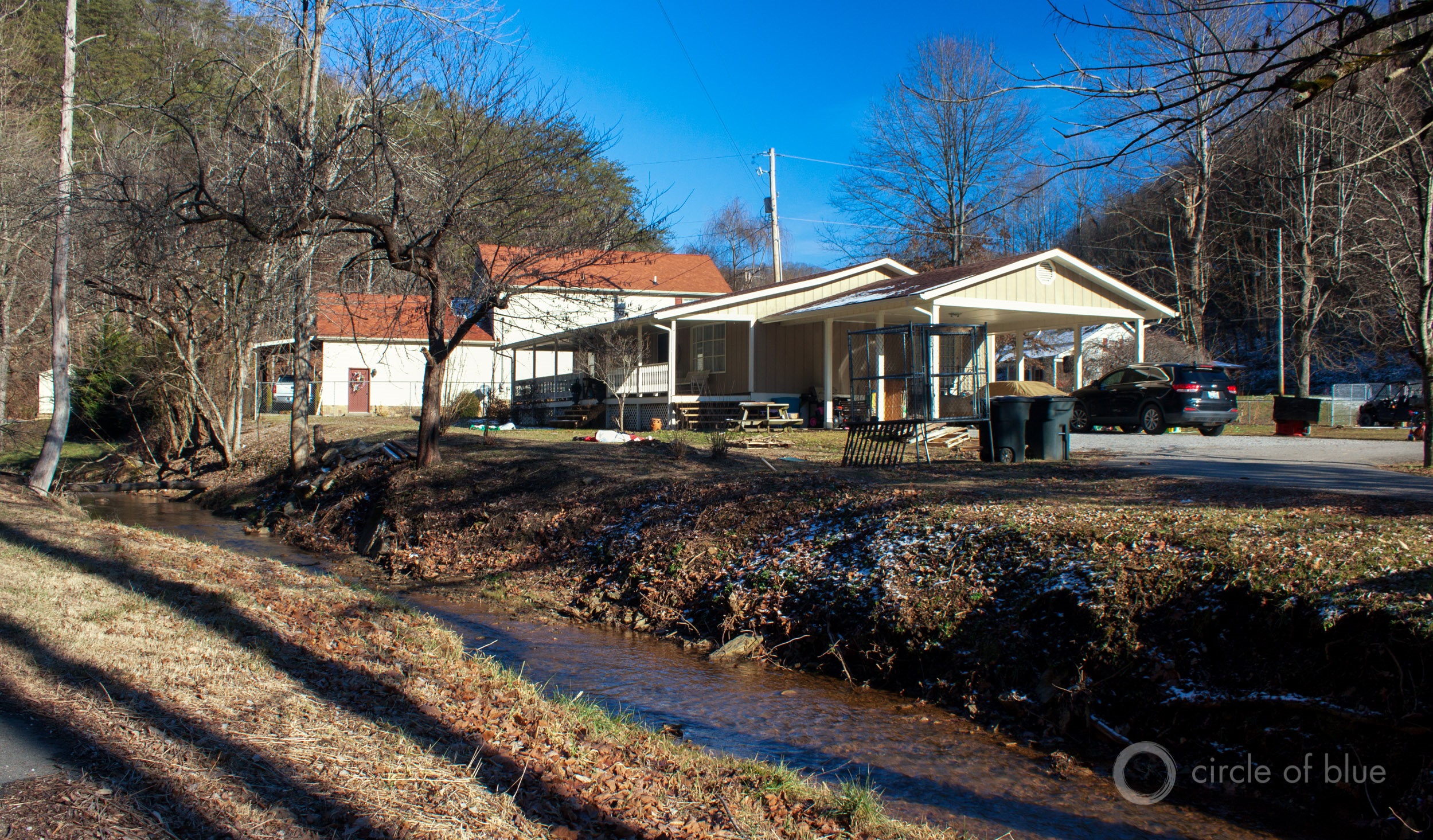
The U.S. Army Corps of Engineers will build a sewer extension to connect roughly 35 homes along the Dry Fork Creek in Letcher County. The homes now use septic tanks and straight pipes to dispose of their wastewater. Photo © Brett Walton / Circle of Blue
Other actions have helped reduce sewage loads. Last October, the institute and the Division of Water sampled three watersheds in Letcher County, adjacent to Harlan. The data are still being analyzed, but the results will inform a sewage management plan in the North Fork of the Kentucky River, one of the state’s most polluted.
What is clear is that bacteria levels in rivers are persistently high. The Water Resources Research Institute found a number of sites that showed fecal coliform levels five times higher than state standards. Volunteers who test the North Fork of the Kentucky routinely submit samples that are two to 10 times above recommended limits for swimming.
Here in Harlan, the magnificent Cumberland River has been designated a no-swim zone by the Kentucky Division of Water for more than two decades because of levels of fecal coliform and pathogens deemed to be a human health risk. The headwaters of the Big Sandy River and the North Fork of the Kentucky River, other major state waterways that flow from the Appalachian crest, have similar impairments.
An unknown number of straight pipes and leaky septic systems continue to pollute creeks while treatment plants are breaking down. The Division of Water’s 2014 water quality report to Congress lists fecal coliform and E. coli bacteria as the leading pollutants in the state’s waterways, a result that mirrors national averages.
“It’s a pretty safe assumption that it’s human feces and not cattle,” Loris Sherman, a biology professor at Somerset Community College and member of Upper Cumberland Watershed Watch, told Circle of Blue about the source of the pathogens. The terrain here is not suitable for the large hog farms, feedlots, or dairies that supply pathogens to rivers in Iowa, eastern North Carolina, or Wisconsin.
Sewage pollution increases the risk of bacterial infection, but it also works in more insidious ways. More organic matter in the water complicates the drinking water treatment process. Operators may have to add extra chlorine, which can result in the formation of cancer-causing disinfection byproducts. Organic matter can eat up oxygen in a river, which leads to dead zones. And pathogens can infiltrate private wells. The Kentucky Cabinet for Health Services noted in 2002 that nearly half of private wells that the department tested had tested positive for fecal coliform.
“Human Waste Going into the Creek”
State and county officials respond to complaints and work with home owners to fix problems. Not all complaints turn out to be true — county health officials told Circle of Blue that some are an attempt at retribution in neighborhood feuds — but the Kentucky Division of Water did not have an estimate of the percent that are valid. If the problem is legitimate and owners do not comply, officials will issue a notice of violation. Repeat offenders can be referred to the county attorney and issued fines.
But one big impediment is that homeowners caught using straight pipes do not fear prosecution. Kevin Nickles, of the Letcher County Health Department, said he could not remember anyone being fined in his jurisdiction for a straight pipe problem. “Most don’t get to court,” he recalled.
County health departments are responsible for septic system permits. But they are not actively searching for straight pipes. They have too many other responsibilities.
“We don’t get paid to walk the creeks,” Frank Davis, environmentalist at the Harlan County Health Department, told Circle of Blue. Straight pipes, in fact, are not his priority. On a limited budget the health department oversees 23 programs, from rabies and tattoo shops to septic tanks, tanning salons, and motels. Food safety is top of the list, Davis said. “Say we have a salmonella outbreak at a restaurant,” Davis conjectured. “You’re talking exposure of fifty to a hundred people. A straight pipe in a creek is maybe two or three over time.”
Goal: Elimination
There used to be more straight pipes, which are relics of poverty and rural living, and the days when there was little regulation of homebuilding. How many, though? No one knows for certain. A survey conducted by PRIDE identified 36,319 straight pipes in the late 1990s. But the assessment revealed only a peek. “You can’t really tell until you do a walk-through along the creeks,” Tammie Wilson, director of PRIDE, told Circle of Blue.
PRIDE was founded in 1997 as an initiative of James Bickford, then the state secretary of Natural Resources and Environmental Protection, and Rep. Rogers, then and still a member of the mighty House Appropriations Committee, which oversees the federal budget.
Rogers’s influence on his home region is profound. Federal money moves mountains here, evident in the new highways that cut through ridges, the flood wall that lines the Cumberland River, and the bus-sized tunnels through Ivy Hill in Harlan that divert the Clover Fork. The Army Corps’ Section 531 program, authorized in 1996 to improve sewers and drinking water in the 5th District, has funded 88 sewer projects in 25 counties over more than two decades. The federal government picks up three-quarters of the cost of those projects.
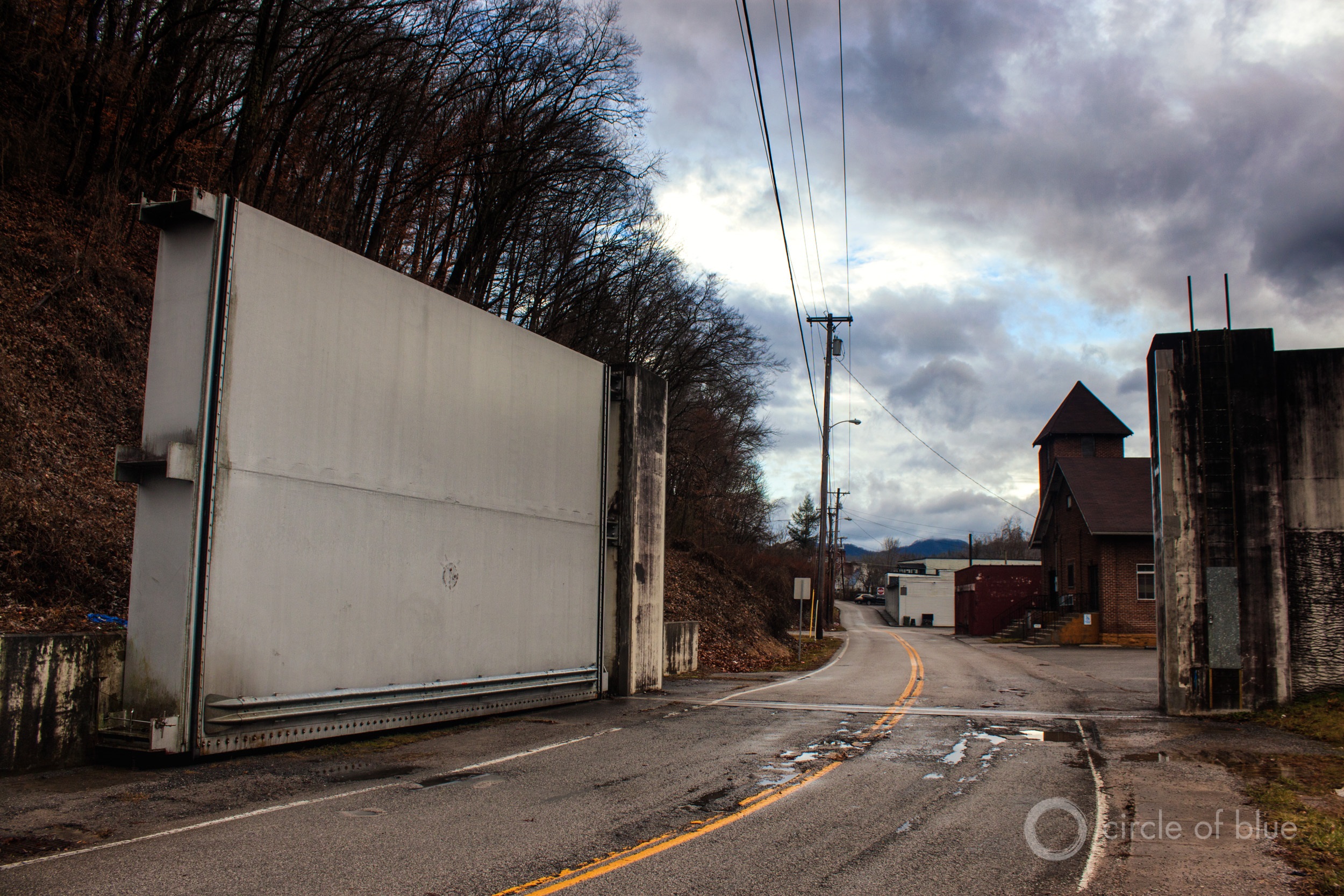
Built by the U.S. Army Corps of Engineers, the towering flood gates that protect Harlan from high water on the forks of the Cumberland River are emblematic of federal investment in eastern Kentucky. Photo © Brett Walton / Circle of Blue
PRIDE, which also works on job training, roadside cleanups, and solid waste, garners near unanimous acclaim for its efforts at a cleaner environment. Some of the federal money, at least $195 million, according to Rogers’s office, was funneled through PRIDE via grants to fix septic systems and build sewers. The group was at the leading edge of the state’s attention to water and sewer in the late 1990s, which was invigorated during the Patton administration.
Patton, like Rogers, is a native son of eastern Kentucky, born in Lawrence County, which borders West Virginia. Patton wanted to raise living standards in his state. In his 2000 budget outline he pledged to bring the “best available” water and sewer service to all Kentuckians by 2020. Sewers would be added where possible, but functioning septic systems and satellite treatment units that serve a dozen or more homes would also qualify.
Patton acknowledged in his budget message that it was a “tough” and “ambitious” goal, made tougher by the mountain terrain and poverty. In Harlan County at that time only 35 percent of residents were served by a sewer system, and in nearby Knott County, the figure was only 5 percent. The upper Cumberland watershed, which covers parts of seven counties and includes Harlan, had an estimated 2,400 straight pipes back then and 4,400 failing septic systems, both likely an undercount of the true number. But Patton, playing the role of cheerleader, was confident that Kentucky would pass the test.
Patton’s 2000 declaration focused attention and resources. That year the Legislature passed SB 409, which led to $500 million in state funding for drinking water and sewer projects. The bill also established a process for selecting water and sewer improvements, and it made the consolidation of small water service providers into larger units a policy objective.
County and city officials, and regional development councils, drew up lists of priority projects that were then forwarded to state agencies for funding. Building upward from local governments made sense. County health departments were on the front lines of the sewage battle, in charge of permitting and inspecting septic systems and responding to straight pipe complaints. They knew where the needs were.
Federal agencies also got involved. The U.S. Environmental Protection Agency’s southeastern region office investigated the viability of alternative septic system designs, focusing on four eastern Kentucky counties. Some areas of the region are ill-suited for standard septic systems. The soil is too rocky or too shallow. Six inches of dirt is not enough for soil microbes to eat the liquid waste. That does not mean septic systems are not a solution; a house might require a different design than the typical tank-and-drain-field model.
“There’s very little that keeps us from doing septic,” said Nickles, the environmental specialist at the Letcher County Health Department. The only drawback to the alternative designs is the cost, which is several thousand dollars higher. “It may not be what people want to pay,” he said.
Sewage Fix Invites Future Problems
The region’s sewage solutions have been funded by money that flowed from state and federal governments and from taxes levied on coal production, called severance taxes. Many of those sources, however, have dried up or considerably diminished.
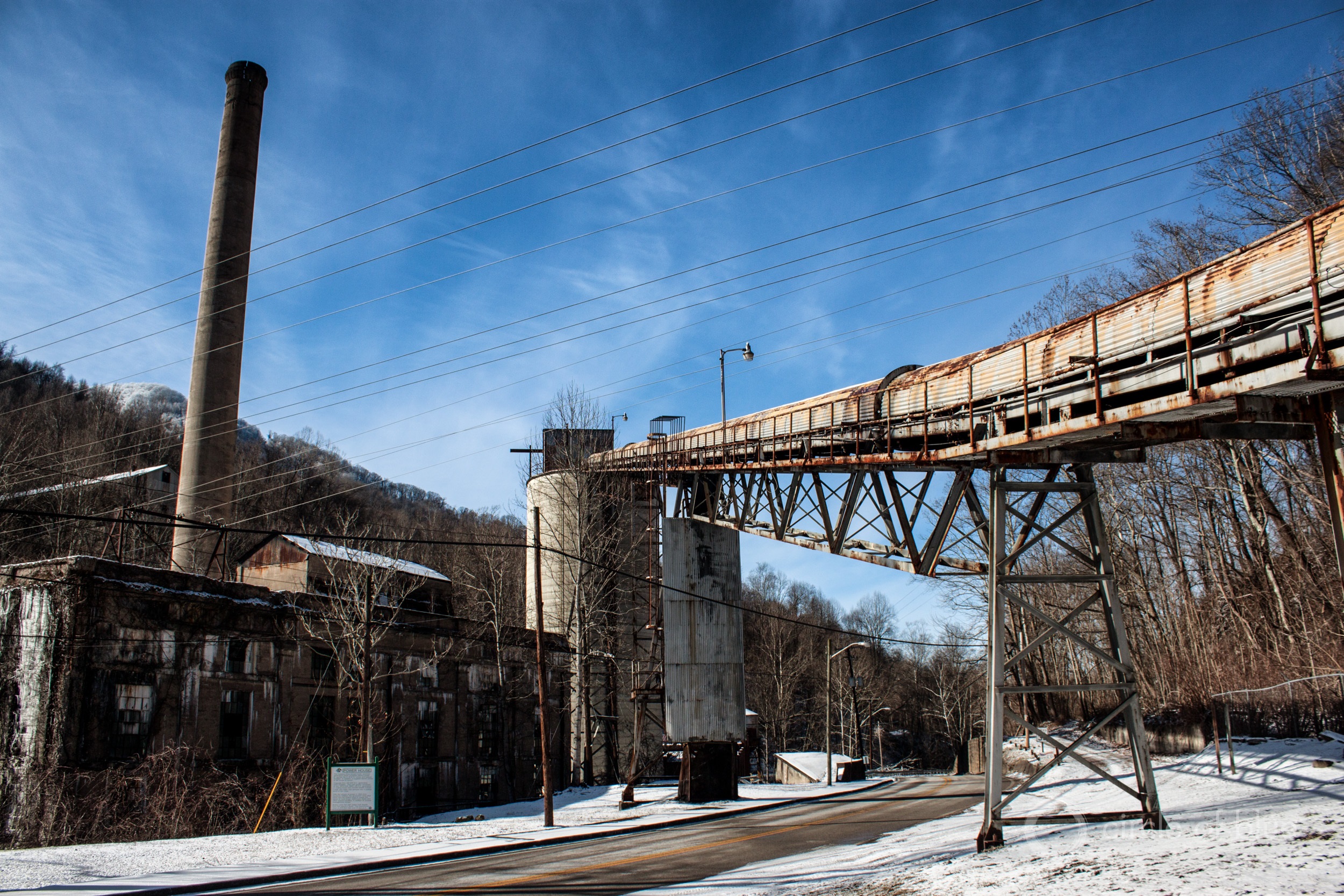
Remnants of Kentucky’s coal industry are scattered throughout the state’s mountain roads. Photo © Brett Walton / Circle of Blue
Before the Great Recession, for instance, the state’s coal industry was still thrumming. Severance taxes hit a recent peak of $298 million in 2012, money that was returned to coal counties to fund sewer extensions as well as roads, schools, and other infrastructure projects.
In 2016, with coal production down to 43 million short tons, tax receipts dropped by more than half, to $120 million.
In an era of tightened federal budgets, grant programs are also endangered. One result is that PRIDE’s septic tank work is now restricted to three counties.
Another result is that existing water treatment systems are breaking down, just like the coal communities, which are greying and shrinking, along with their budgets and economic base. Harlan County was home to 42,000 people in 1980. The next census will likely show fewer than 27,000 people.
Dan Mosley, the county executive, said that in past years Harlan County had received as much as $5 million per year in coal severance grants. Now the fund is providing little more than $1 million per year to the county.
“My concern moving forward is funding for rehabilitation of systems that were put in with coal severance money years ago,” Mosley wrote in an email to Circle of Blue. “With those funds no longer available, it’s going to be tough to rehab in the future. We have several areas that need immediate water rehab. Other areas here will [need repairs] within the next 5 years. Not sure where the funds will come from.”
“Unfortunately when you have grants to put in lines, a community may not raise rates adequately to maintain the system,” Gary Larimore, director of the Kentucky Rural Water Association, told Circle of Blue.
“I don’t know that there’s any part of the county where what we have is being kept up,” Alex Beer, watershed coordinator for Headwaters, Inc., a river group in Letcher County, told Circle of Blue. Maintenance failures are a documented problem, but there’s not enough money to patch all the holes, she said.
State officials are beginning to look at what can be done. “One of my goals is to make sure that communities receiving funds are financially viable,” Donna McNeil, executive director of the Kentucky Infrastructure Authority, told Circle of Blue. The authority makes loans for water and sewer projects. But how to do that? McNeil, who has been on the job for a year, is trying to figure that out. She is part of a Division of Water work group that is examining financial factors for grant and loan programs.
These are not easy questions, and not just in Kentucky. They are being asked in Sacramento and Raleigh and the nation’s capital. California, for one, is considering a state fund to subsidize the operation and maintenance of water systems in poor communities, but that proposal has stalled because of a disagreement about whether a $0.95 monthly fee on residential water bills is the appropriate revenue source.
The Kentucky Division of Water told the Legislature in a 2017 report that it would need a number of legislative solutions to cut sewage pollution from 180 small, privately owned wastewater plants, such as those operated by a mobile home park or an apartment complex. Those recommendations included a new funding source and the authority to take over the management of a small system that is a public health risk.
When pressed for a solution to straight pipes and failing water treatment systems many people fall back on a version of the same answer, that more money is needed — whether that is expressed in skilled managers, funds for repairs, system consolidations, or functioning septic systems. The state estimates it needs $2.1 billion over the next decade to fix and expand sewer systems, some $600 million in eastern Kentucky alone. Others say that the state cannot continue to pursue a strategy of sewer line extensions and other “big-pipe solutions” when long-term maintenance is an obvious impediment.
“Funding is…” Nickles started to say at the end of a discussion at the Letcher County Health Department, before pausing and shaking his head. He finished his thought by repeating what he said earlier about septic system designs. “Most everything comes back to money,” he said.
Brett writes about agriculture, energy, infrastructure, and the politics and economics of water in the United States. He also writes the Federal Water Tap, Circle of Blue’s weekly digest of U.S. government water news. He is the winner of two Society of Environmental Journalists reporting awards, one of the top honors in American environmental journalism: first place for explanatory reporting for a series on septic system pollution in the United States(2016) and third place for beat reporting in a small market (2014). He received the Sierra Club’s Distinguished Service Award in 2018. Brett lives in Seattle, where he hikes the mountains and bakes pies. Contact Brett Walton

